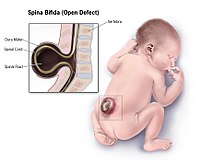
Photo from wikipedia
INTRODUCTION Recognition of tethered cord syndrome (TCS) in children is important because as the child grows, the spinal cord is stretched, leading to ischemia and subsequent neurological deficits, including bowel… Click to show full abstract
INTRODUCTION Recognition of tethered cord syndrome (TCS) in children is important because as the child grows, the spinal cord is stretched, leading to ischemia and subsequent neurological deficits, including bowel or bladder dysfunction, back and leg pain, or lower extremity weakness. Imaging findings raising concerns for tethering include presence of a fatty and/or thickened filum or a conus medullaris located caudal to L2. OBJECTIVES The objective of this study was to describe the symptomatic presentation of TCS in our institution, detect demographic and diagnostic predictors of signs and symptoms, assess changes in symptoms over time, and examine whether demographic and diagnostic variables affect changes in symptoms over time. METHODS Using a retrospective chart review from patients who underwent detethering at our institution between 4/1/2015 and 3/31/2019, we report on the signs and symptoms of patients undergoing detethering surgery at presentation and examine possible demographic and diagnostic predictors of those symptoms and changes in symptoms over time. Logistic regression analyses were used to determine whether symptoms at presentation were related to demographic and diagnostic predictors and to assess change in symptoms over time. RESULTS 273 patients underwent detethering and were analyzed. Of these, 144 (53%) were <5 years of age, 151 (55%) were male, 233 (85%) had a fatty filum, 179 (66%) had a thickened filum, and 106 (39%) had a low-lying conus. Patients <5 years of age were less likely to have urological, gastrointestinal, and neurological or orthopedic symptoms; patients with thickened fila (i.e. greater than 2mm in diameter regardless of fat-infiltration) were less likely to have urological symptoms; patients with low lying coni were less likely to have gastrointestinal symptoms. Patients exhibiting symptoms at presentation had reduced rates of symptoms at follow-up, but reduction in rates of symptoms over time were unrelated to demographic or diagnostic variables. Surprisingly, 123 (45%) patients presented with intractable constipation. CONCLUSION In the population studied, several presenting symptoms, particularly constipation, were commonly reported. Children <5 years old were less likely to manifest clinically evident neurologic/orthopedic, urological, and gastrointestinal symptoms than the older cohorts. Patients were less likely to report symptoms at both their first and second postoperative visit compared to presentation.
Journal Title: Pediatric neurosurgery
Year Published: 2022
Link to full text (if available)
Share on Social Media: Sign Up to like & get
recommendations!